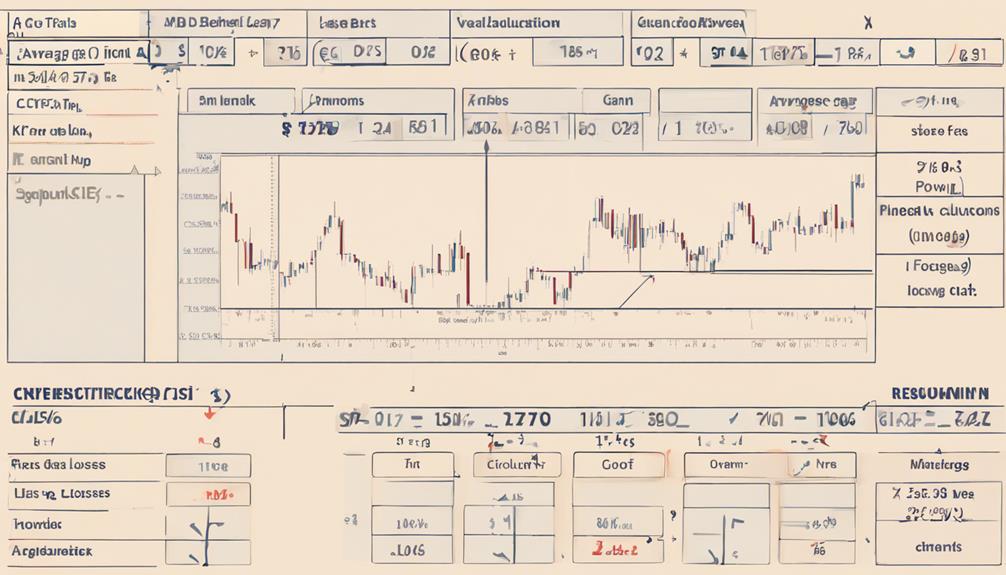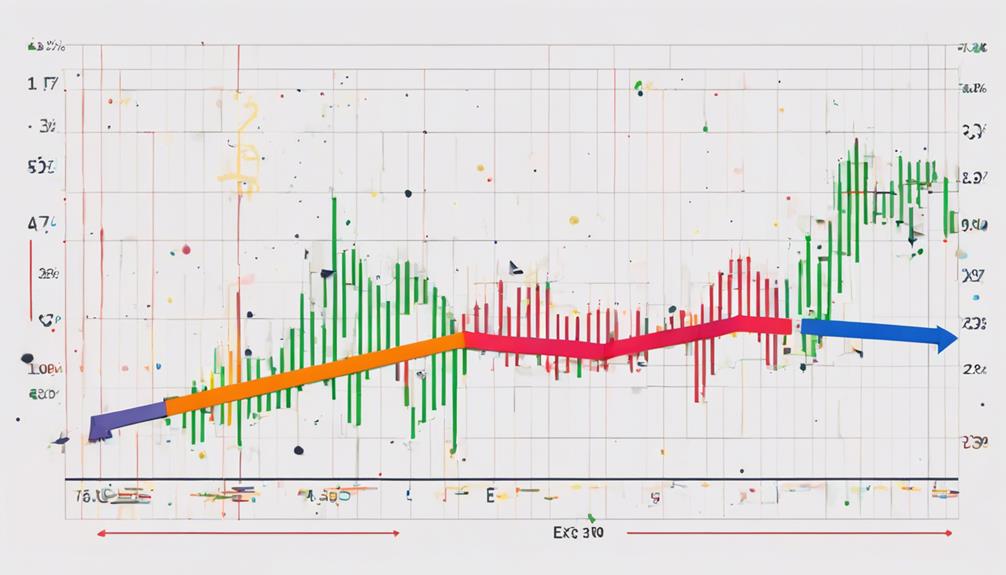To calculate the Relative Strength Index (RSI) as a beginner, start by gathering historical closing prices and accurately classifying daily movements as gains or losses. Calculate average gains by summing positive changes and losses by adding negative ones. Divide the sums by the number of periods to get the averages. Then, use these average gains and losses to determine the RSI, which ranges from 0 to 100. Above 70 suggests a downward correction possibility, while below 30 indicates a potential upward correction. Mastering these 3 simple steps will provide a solid foundation for interpreting RSI trends effectively.
Gathering Closing Prices and Classification
To effectively initiate the RSI calculation process, the first step involves gathering historical closing prices for a specific trading period, typically spanning 14 days, and meticulously classifying each day's price movement as either a gain or a loss based on its relationship to the previous day's closing price.
This meticulous categorization of price movements is vital for accurately computing the Relative Strength Index (RSI), a key technical analysis indicator used by traders to assess the strength and momentum of a market. By tracking and organizing the daily price changes, traders can determine the average gains and losses over the specified period, providing essential data for RSI calculations.
Consistency in tracking and classifying closing prices is paramount to guarantee the reliability and relevance of the RSI values generated. This systematic approach lays the foundation for interpreting RSI trends effectively, enabling traders to make informed decisions based on the market's strength and price movements.
Calculating Average Gains and Losses

The process of calculating average gains and losses plays an important role in determining the Relative Strength Index (RSI) values for a given trading period.
Average gains are computed by summing up positive price changes over a specified period, while average losses are determined by adding negative price changes during the same timeframe.
To calculate the average gain, divide the sum of gains by the number of periods, and for the average loss, divide the sum of losses by the number of periods.
These average gain and loss values are vital in computing the Relative Strength (RS) in the RSI formula.
By understanding and accurately calculating these averages, traders can then proceed to determine the RSI indicator, which is a momentum oscillator that measures the speed and change of price movements.
The RS formula incorporates these average gains and losses to provide insights into the strength of a security's price changes over a given period, aiding traders in making informed decisions based on market trends and momentum.
Determining Relative Strength Index (RSI)

In the context of Relative Strength Index (RSI) analysis, the calculation involves utilizing the average gains and losses over a specific timeframe to assess the relative strength of a security. The Relative Strength Index (RSI) calculation plays an important role in helping traders understand market conditions and make informed decisions.
Here are key points to take into account when determining the RSI:
- RSI Values: The RSI indicator ranges from 0 to 100. Values above 70 suggest that the security may be overbought, indicating a potential downward correction. Conversely, values below 30 signal oversold conditions, hinting at a possible upward correction.
- Buy and Sell Signals: By applying the final RSI formula (100 – 100 / (1 + RS)), traders can interpret RSI values to identify buy or sell signals. This allows traders to capitalize on potential market movements based on the RSI analysis.
- Momentum Assessment: RSI calculation provides insights into the momentum of a security. Understanding the momentum can assist traders in gauging market conditions and making strategic trading decisions.
Frequently Asked Questions
What Is RSI for Dummies?
RSI, or Relative Strength Index, is a simplified momentum oscillator used to gauge overbought and oversold conditions in a security. This beginner-friendly indicator ranges from 0 to 100, with values above 70 signaling overbought levels and below 30 indicating oversold conditions.
Understanding RSI basics involves interpreting these levels for potential trading signals. RSI for dummies offers a straightforward guide to grasping this key technical analysis tool for market analysis and decision-making.
What Is the Basic RSI Indicator?
The basic RSI indicator is a pivotal tool in technical analysis, offering insights into security strength through the measurement of recent price changes on a scale of zero to 100. It aids in identifying overbought and oversold conditions, trend reversals, and potential buy/sell opportunities.
Understanding the RSI calculation process, interpretation guide, trading strategies, historical data analysis, trend identification, and momentum analysis is essential for informed decision-making in financial markets.
What Are the Basic RSI Settings?
The fundamental RSI settings encompass essential parameters like the period, typically set at 14, determining the timeframe for analysis. These settings define the overbought and oversold levels at 70 and 30, respectively, guiding traders in devising effective RSI strategies.
How to Calculate RSI in Excel With an Example?
To calculate RSI in Excel, use formulas to compute average gains and losses, relative strength (RS), and RSI values. Utilize historical stock market data for analysis.
RSI aids in technical analysis by identifying trends, price movements, and potential trading strategies. By graphing RSI values against time, investors gain insights for informed investment decisions based on market trends and chart patterns.
Excel's data analysis capabilities streamline RSI calculations for efficient market analysis.
Conclusion
To sum up, mastering the calculation of the Relative Strength Index (RSI) involves:
- Gathering closing prices.
- Calculating average gains and losses.
- Determining the RSI value.
This three-step process is essential for beginners looking to analyze market trends and make informed trading decisions.
By following these steps diligently, investors can gain valuable insights into the strength and direction of a particular asset's price movement.


